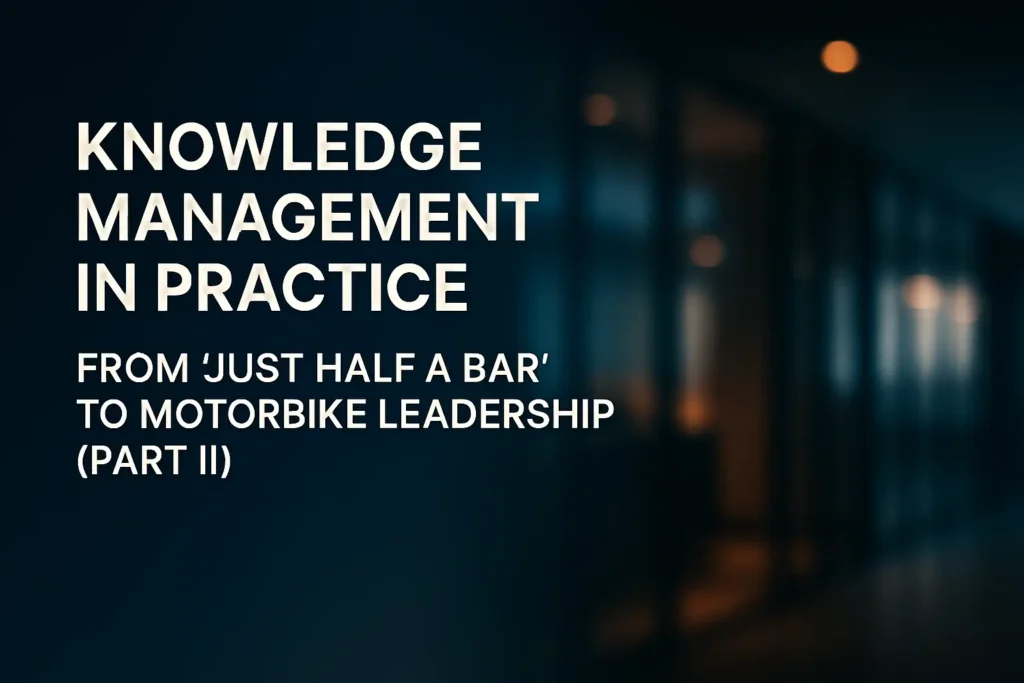This article is the second part of a series where I share real-world stories of knowledge management (KM) challenges and lessons learned from organizations across different industries in Iran. Each story reflects not only the situations organizations face but also the deeper insights into why knowledge management matters and what happens when it is absent—or when it is successfully applied.
The aim of this series is not to present abstract theories, but to bring KM to life through anecdotes, humor, and reflection. Just as in the first article (“From Mischievous Cats to the Miracle Room”), here too you will find unusual stories—from a repairman who solved a months-long technical crisis in five minutes, to a bank manager who insisted that his employees had “no knowledge to share,” to a leader who rode a motorcycle to understand his frontline staff.

Each example is followed by analysis, linking the case back to the KM cycle and its enablers.
Just Half a Bar!
During a visit to a mining company for a KM project, one of the staff shared a fascinating experience. The company used a mechanical hammer in its production process, but the machine repeatedly overheated after a short time and had to be stopped so it could cool down. This constant downtime severely affected productivity.
The company contacted several well-known repair firms, but none could solve the problem. Eventually, in desperation, a colleague recommended a local repairman working in another company nearby. To everyone’s surprise, the repairman arrived at the factory wearing a suit, carrying no tools at all. The staff were puzzled: “Aren’t you going to need equipment to fix this?”
The repairman calmly replied: “When you described the issue to me, I already knew the solution from past experience.” He walked over to the machine, adjusted the hydraulic oil pressure by lowering it just half a bar, and within five minutes, the problem that had plagued the plant for months was gone.
This story is a vivid illustration of knowledge mapping—the process of knowing who knows what within or beyond the organization. The technical solution was simple, but only if the right expertise was identified. Without mapping, organizations waste enormous amounts of time and money chasing the wrong solutions.
It also shows the value of tacit knowledge (experience stored in people’s heads) and the risk of not having it systematically captured or made accessible. Had the company documented similar cases, they could have solved the issue internally.
These Experiences Are Useless!
In another case, while working with a leading petrochemical company, a senior manager made a striking comment:
“I have no need for my employees’ tacit experiences. Their experiences are useless!”
At first, this seemed shocking—how could experience be useless? But the manager, with over 30 years of industry expertise, explained further. Many of his staff, due to reasons such as overconfidence, lack of English proficiency, or simply negligence, failed to properly study the operating manuals and standard procedures for complex equipment. Instead, they learned through trial and error, often causing costly mistakes.
They would then present these “hard-earned lessons” as organizational knowledge, uploading them into the KM system. The manager’s point was that these so-called “lessons” were already explicitly documented years ago in manuals and guidelines. Rather than rediscovering the wheel, employees should have engaged with existing explicit knowledge first.
This highlights the often-overlooked importance of explicit knowledge. Organizations sometimes focus so heavily on tacit knowledge that they neglect to ensure employees are actually using the vast body of documented knowledge already available.
Good KM practices balance both tacit and explicit knowledge. Employees must be trained not only to share their experiences but also to search, access, and apply documented procedures—preventing costly reinvention.
We Don’t Have Knowledge!
In the kickoff meeting for a KM initiative at a major private bank, one manager stated bluntly:
“Our employees don’t really have knowledge to share. All we have are policies, regulations, and procedures—that’s it.”
He argued that the organization’s knowledge had reached a “break-even point”: there was nothing left beyond the documented rules.
Through discussion, two important clarifications emerged:
- Explicit Knowledge Still Matters. Even if most organizational knowledge is in documents, employees often lack awareness or mastery of this knowledge. KM is not just about generating new content; it is also about ensuring accessibility, learning, and application of what already exists.
- Different Levels of Knowledge. Referring to Zack’s model, we can classify knowledge into three levels:
- Foundational Knowledge (basic processes and procedures)
- Advanced Knowledge (specialized skills and problem-solving approaches)
- Innovative Knowledge (new methods, R&D, and innovation).
Frontline employees are not necessarily expected to generate groundbreaking innovations; their role is to master foundational and advanced knowledge. Expecting innovation from everyone creates frustration, but ignoring their need to fully understand existing knowledge is equally harmful.
This story shows that KM professionals must clarify expectations. Not all knowledge is innovative, and that’s fine. KM must ensure that employees effectively use foundational and advanced knowledge, while specialized units focus on innovation.
Will the System Work?
In another large bank, during a demo of a KM platform, an IT manager expressed concern:
“We have more than 30,000 employees. Can your system handle participation from so many people?”
The answer given was straightforward: No KM initiative has ever involved 100% of employees. In fact, not all employees want to participate, not all are motivated, and not all have knowledge worth sharing. This is true not just for KM, but for all organizational improvement systems.
A training manager from the same bank added that in their e-learning platform—running for over a decade—only around 10% of employees were truly active and engaged.
This case demonstrates the importance of realistic expectations. Effective KM does not require total participation. What matters is identifying and engaging the right groups: knowledge creators, key practitioners, and motivated contributors. The system should be designed for these core users, while still allowing broader access.
The Motorbike Manager!
At a recent seminar on KM for a private-sector company, one senior manager shared a remarkable leadership story. He began by asking:
“What do leadership, friendship, and citizenship really mean?”
He explained:
- Leadership means employees allow someone to lead them.
- Friendship means someone allows another to be their friend.
- Citizenship means a city allows someone to be its citizen.
He then recounted his own experience years earlier, when he was tasked with boosting the sales of POS (point-of-sale) machines at another company. Instead of relying solely on reports, he decided to join the frontline staff. For three months, he rode a motorbike and performed the daily tasks of POS operators—meeting merchants, installing machines, and solving issues firsthand.
This deep immersion gave him an authentic understanding of the challenges his staff faced. Later, he organized a major gathering to recognize and celebrate top-performing operators. The results were transformative: within a short time, the company became the market leader in electronic payment services.
This story is a powerful example of leadership as an enabler of KM. By engaging directly with frontline work, the manager built trust, gathered tacit insights, and created a culture where knowledge flowed upward as well as downward. His motorbike rides symbolized humility, empathy, and the willingness to learn from those closest to the customers.
Conclusion
From mining equipment fixed by lowering “half a bar” of oil pressure, to the skepticism of petrochemical managers, to banks wrestling with the role of explicit knowledge, and finally to a leader who transformed his company by riding a motorbike—these stories show the diverse realities of knowledge management in action.
The common thread is that KM is not an abstract concept—it is deeply tied to people, leadership, systems, and culture. Sometimes the answer is already documented but ignored; sometimes the key is knowing who has the expertise; sometimes it’s about setting realistic expectations of participation; and sometimes it’s about leaders rolling up their sleeves and riding with their staff. Knowledge management, at its heart, is about making knowledge visible, accessible, and usable—so that organizations can learn faster than their challenges appear
Subscribe to receive free webinar notifications on Knowledge Management.

